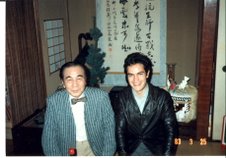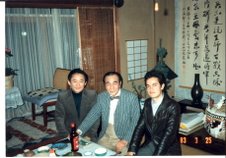Río Bravo
Río Bravo is a piece for large chamber ensemble, of eleven minutes’ duration. It was commissioned by Joel Sachs for his New Juilliard Ensemble.
The size and makeup of the ensemble are similar to those in Notes from Underground, the work I wrote in 2015 to poems by Sean O’Brien. For this reason, among others, I had intended the new piece to be a natural continuation to the previous one.
As well as feeling like the natural thing to do, it is always reassuring to be able to pick up from where one left off. A phrase by Octavio Paz comes to mind: a poet has no biography - his work is his biography. It would be untruthful to say that my work is intentionally autobiographical, but there are many ways in which surroundings, atmospheres, social context and historical moment determine one’s musical thinking. In this broader context, one’s state of mind, which is the result of past, recent and contemporaneous experiences, are, inescapably, a strong factor too.
Then there is the element of continuity. I would not class this as inescapable, but it does also seem a natural thing to do to take material from the last piece as the springboard for the new one. Often towards the end of a compositional process, with the deadline looming large, something happens, and idea comes up that serves to break a deadlock, to turn a corner. This idea performs its useful role, the purpose for which it was conjured up, but then, instead of staying there, it refuses to go away. It shows to have an afterlife, an energy which the immediate use that was made of it has not exhausted. That is the typical candidate to be a springboard for the next piece.
For the Juilliard commission, I had decided quite clearly what I wanted to do: my intention was to revisit the Kobold. For those who don’t know - and I certainly didn’t before my collaboration with Sean O’Brien - the Kobold is a presence, a being, a sprite. This is not the place to explain at length, but suffice it to say that the Kobold is often found in underground locations. O’Brien invoked it as a creature of the mines, and this, of course, has strong echoes of el Tío, the presence that rules the mines up in the Andes.
The Kobold gets only a passing mention in O’Brien’s Notes from Underground. Accordingly, the musical treatment it receives there is perforce ephemeral. In 2015 this left me with a thirst for more; the Kobold had much to offer yet, and I had only skimmed its surface. The Juilliard commission was to be the opportunity to grapple with it as it deserves: a whole new piece devoted to it. But it was not to be.
Life intervened. December 2015 saw some of the worst floods ever seen in England, and the very worst occurred in the north. The river Tyne flowed through Newcastle with a strength not seen in 240 years. Whole areas in towns such as Corbridge were invaded by the overflowing North Tyne. My particular location up in Northumberland – bordered by the river Rede, and within a few hundred yards of its confluence with the North Tyne – was certainly not spared. On 5 December the Rede grew to many times its usual, flooding fields and dwellings. Compounded by runoff water coming from the neighbouring hills, this made for a rather worrying situation. Mercifully the old stone house where I live was spared the worst (“They knew how to build houses in them days” goes the local wisdom. And where to build them, one might add; near two rivers we may be, but we have seen a lot of weather in the last decade, but somehow have come out unscathed). But the sense of threat persisted. December wore on, the rain refused to abate and the same combination of meteorological factors happened, albeit with lesser intensity, another four times. A sense of relative safety only returned around mid-January.
The experience of seeing the Rede, a melodious companion of many years, turning into a roaring, destructive monster, had a strong effect. So did seeing towns close to me, like Hexham and Corbridge, flooded, and hearing the many tales of distress from Cumbria in the west. What was going on was impossible to evade. Not for the first time, I found myself in situation where compositional plans seemed an indulgence that reality could not afford. Of course music cannot change things, let alone climate - or climate change, for that matter. But, in times disaster such as this, as some people where writing to the press, others were praying and others were talking things over in the pub, I could not abstract myself from the pressing reality to write music about Kobolds. I had to write about storms, about rain, and, above everything else, about river. I persisted for a while, insisting on my fruitless sketches about the Kobold. Then I yielded to the surrounding reality, and began to plan a piece about the river. The … was fairly obvious. There was to be a gentle, melodious music to start with, and then the same material was to be transfigured to be stated as menacing, violent, destructive. This did not take much thought at all, and the general state of emergency urged me to get down to work - as did the agreed completion deadline for New Juilliard Ensemble. I even had a title in mind: Río Manso, Río Bravo. (Note to bilingual readers: I have not forgotten Spanish titles do not carry capitals in every word, but this title was to be a playful allusion to possible river names.)
Since I was surrounded by stormy weather and by daily news about floods and destruction, it was the second section in the proposed scheme that felt most relevant, so I started composing that. What came out was, unsurprisingly, music that was aggressive, urgent, obsessive even. I intended to develop that to a length equivalent to one-half of the piece’s duration. But it grew, like the river. It grew beyond its allocated duration, and it took over the piece. This was not the time for gentle rivers. This was the time to be aggressive, urgent and obsessive.
The resulting piece, Río Bravo, was premièred on 21 April by New Juilliard Ensemble conducted by Joel Sachs. It is always thrilling to go to New York, specially if it is to hear a new piece at Lincoln Center. The players from Juilliard are always outstanding, and this time was no exception. I had been apprehensive about the demands of the percussion part, particularly the vibraphone sections. I need not have worried, since the appointed percussionist turned out to be none other than Sae Hashimoto, a virtuoso of uncommon character and technique.
Joel Sachs put together a fascinating programme of recent music. Special revelations were composers Saad Haddad, Joshua Cerdenia and Rica Narimoto. Each had an individual statement to make and the the players and conductor gave confident renditions of one impressive piece after another.
The New York Times printed the most noncommittal review I ever remember reading. Perhaps many composers have a similar story to tell. Hostile reviews, I have had a fair share of them. Indifferent ones too. But non-reviews? The only comparable precedent that comes to mind is a review in The Guardian apropos of Peter Maxwell Davies’s Worldes Bliss in 1969: “In it, Mr Davies uses combinations of instruments.” End of review.



